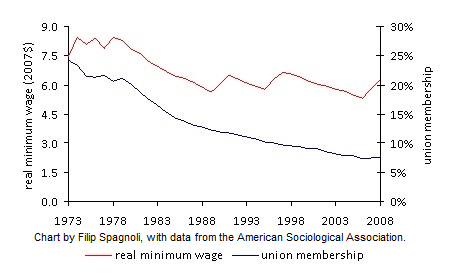Continues from previous page.

Union membership and federal minimum wage chart (1973-2007): American union participation and the federal minimum wage have declined in tandem. Graph by the statistician and philosopher Filip Spagnoli with data from a report by the American Sociological Association.
The above graph from clearly shows a relationship between declining union participation and the declining federal minimum wage. The sharp spike in 2009, of course, comes from Congress’ last wage hike before the Republicans took over in 2010. In 1954, 34.8% of American workers were union members. By 1978, the percentage had dropped to 23.6%, and in 2012, a scant 11.3% of American workers participated in unions [data from Cornell University and BLS ]. This comes as no surprise. During the 1930’s-1960’s, unions set standards for wages in their industries and pushed wages up. That pressure no longer exists.
Why have unions declined since the late 1960′s? The [U.K.] Guardian ‘s Richard Wolff lays some of the blame on conservatives:
The New Deal ‘s enemies – big business, Republicans, conservatives – had developed a coordinated strategy by the late 1940s. They would break up the coalition of organized labor, socialist and communist parties: the mass base that had forced through the 1930’s New Deal. Then each coalition member could be individually destroyed. […] Nor did labor unions or the left find or implement any successful strategy to counter the 50-year program aimed to destroy them.
But part of the problem is that Americans began to distrust unions, and unions stopped reaching out to non-unionized workers. Also, Public support for unions tends to plummet when the job market’s poor. As technology and outsourcing displaced more and more workers (while conservative policies increased their suffering) Americans began distrusting all big institutions, including unions. And the U.S. government. Nor did the famous labor leader Jimmy Hoffa ‘s shady mob ties and mysterious disappearance in 1982 help.
Labor unions gave us child labor laws, the federal minimum wage, 8-hour work days, safety regulations, health insurance, and other rights and amenities we take for granted.
As I wrote in a previous article, “5 Reasons Why We Love Labor Unions And Need Them More Than Ever ,” unions gave us child labor laws, the federal minimum wage, 8-hour work days, safety regulations, health insurance, and other rights we take for granted. Now, corporations are trying to get around them by shipping jobs overseas and unfairly forcing American workers to compete against low wage workers with few or no rights.
I also wrote that the minimum wage is a core accomplishment of the labor movement. Although the federal minimum wage hasn’t kept up, 19 states in the U.S. have higher minimum wages. Yet, the Institute for America’s Future announced that 40% of Americans make less than 1968′s minimum wage, as measured in today’s dollars.
Hope for labor unions and a higher federal minimum wage.
Unions are now re-energized and forging alliances with religious, community, and political groups. In recent years, they’ve helped non-union workers organize for better work conditions and a living wage. This year’s fast food worker strikes and the OurWalmart protests show that unions are getting more media-savvy, as well. Meanwhile, the United Farm WorkersUnion has created a foundation for the immigration issues faced by many of their constituents.
If we could only lock those Republicans in Congress up in a dungeon somewhere, things might actually look hopeful. Studies from both conservative and liberal think tanks recommend raising the federal minimum wage . Meanwhile, Australiarecently raised their to over $16.00 per hour with no downside. A Gallup poll taken shortly before the 2013 Labor Day Weekend reveals that 54% of Americans hold favorable opinions about unions — not as good as the 75% high mark in 1956, but a two percent improvement over last year’s poll.
NEXT: Technology.

